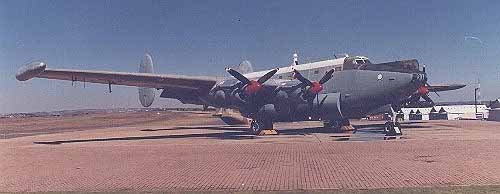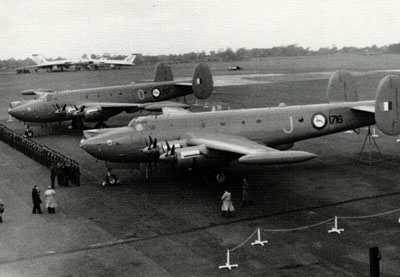
History of Shackleton 1721/N

Shackleton 1721/N as she now stands at AFB Swartkop before any restoration attempts.
In accordance with contract B1/8129 dated March 1954 SAAF serial #1721/N was built as one of a batch of eight Avro Type 716 Shackleton M.R.3 's numbered 1716-1723. 1721/N (construction #1531) was built during 1957. It was the fourteenth M.R.3 built and was originally classified as an M.R.3 Phase One. It was fitted with special bomb doors to accomodate for the attachment points of the SARO (Saunders-Roe) Mk.3 lifeboat. Only three Shackletons in SAAF service had been configured in this manner. It was test-flown at Avro Woodford on the 12th of December 1957 and was painted in 35 sqn. markings, and coded N. 1721/N was the first Shackleton to arrive with the paint scheme that would be the basic 35 sqn. paint scheme (also applied to maritime C-47's in later years). 1716-18 arrived in grey with Springbok roundels and 1719+20 arrived with orange not gold springboks on the castle insignia.
She was accepted from Avro on the 30th of
January 1958 and was ferried to South Africa leaving on the 13th
of February 1958 with 1722/P and 1723/Q. They flew via St.Eval
and arrived at their new homes on the 26th of February 1958. One
of 1721/N's first missions was the escort of the HMS Protector on
the 22nd of April 1958.
On the 10th of September 1962 1721/N had to perform a belly-landing at AFS Ysterplaat but was duly repaired, although not appearing on the logbooks for quite some time. Interestingly enough the bomb-doors she was then fitted with (as well as the nose-wheel doors) are in fact stamped 1956 - before she was even built - so it would appear that she was repaired from a pre-production parts stockpile.
During 1971 she was involved with the sinking of the Wafra oil tanker. The Wafra was threatening on an oil spill. SAAF Buccaneer's came to sink her, but with no luck. 1721/N then came along and sunk her with depth charges. By 1973 she had been brought up to full M.R.3 Phase 3 standard. During 1975 she participated in the patrol in looking after Portuguese refugees. During 1982 she was the star of the Ysterplaat Open Day gracing several pages as well the cover of the programme and giving a beautiful afternoon air display.
She was to become one of the last three flying Shackleton M.R.3's in the world. After some formation flying and a photo shoot that would have made Twiggy blush in her heyday, 1721/N led 1722/P and 1716/J to carry out the last operational Shackleton flight and did their formation flypast at the official retirement ceremony at Cape Town International airport (then D.F. Malan) on the 23rd of November 1984. In any case the parts situation was so sticky that after only a few hours of general flying major component changes were necessary. During December 1984, 1721/N was ferried to AFB Swartkop for the SAAF Museum.
For many years 1721/N was kept in ground-running condition until it was decided to get 1716/J flying again. 1721/N was then cold-heartedly stripped out for engine spares, electrics, upholstery and was pushed under a construction known as the spandome (which was not unlike a giant dome tent). One night during 1996 a freak wind collapsed this structure onto 1721/N and the four main girders (approx. 1 foot in girth) caused extensive damage to the aircraft.
1721/N was patched for display purposes and even after the loss of 1716/J was still as unloved as ever. Gradually the paint turned creamy blue, the oleo legs collapsed, the tyres went flat and the perspex turned yellow and became crazed. What was left of the interior was gradually reduced by time, the harsh sun, constant parts theft, rain and hail. Now it's a showpiece of shameless neglect and 1721/N is in danger of becoming just like her other 6 sisters, a stripped corroding hulk of forgotten metal.
With compliments Roo Consultants